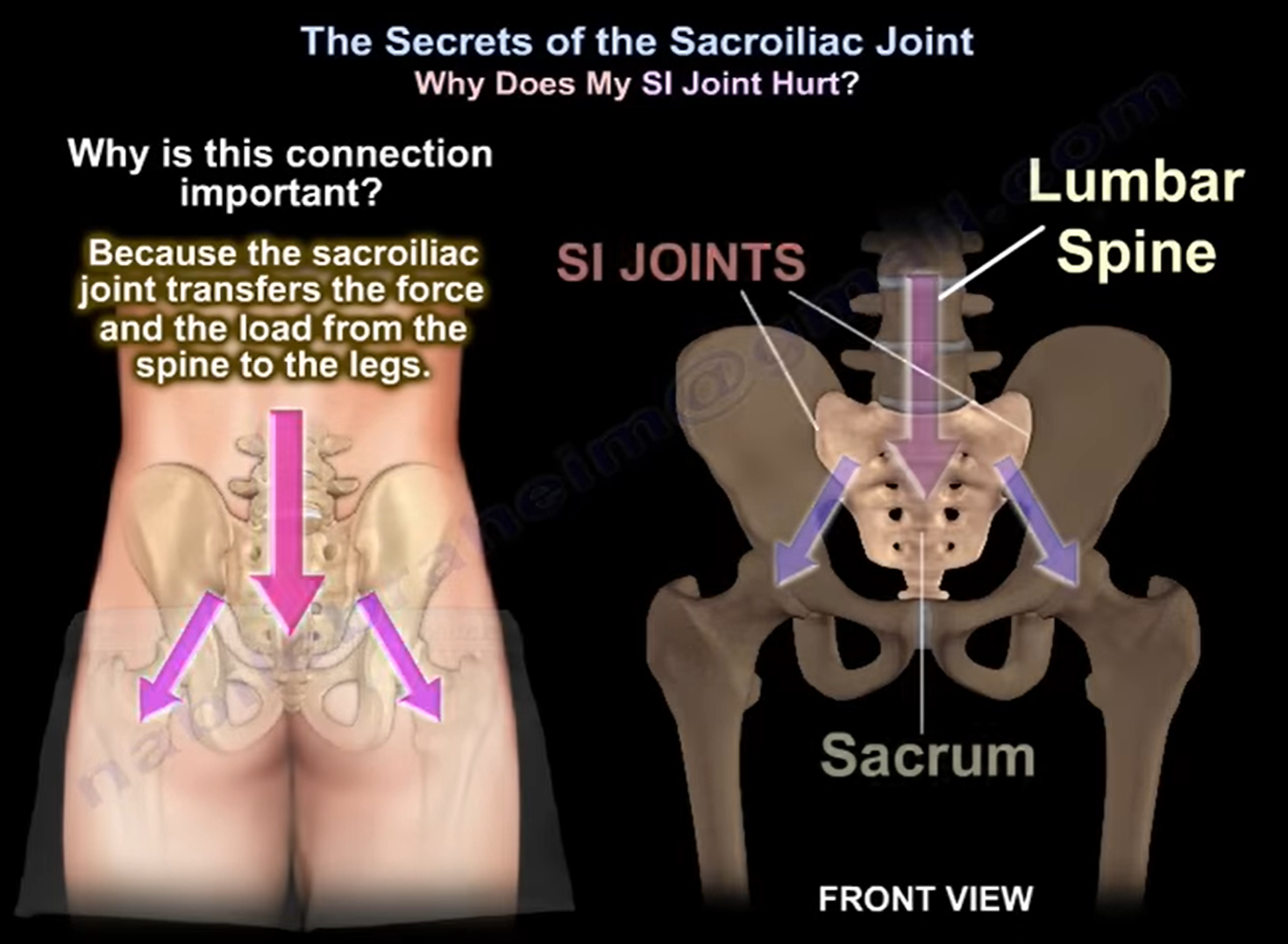Courtesy: Prof Nabil Ebraheim, University of Toledo, Ohio, USA
Why does my sacroiliac joint hurt?
- The sacroiliac (SI) joint is frequently overlooked as an important cause of low back pain, contributing to approximately 22% of cases. It is involved in nearly 40% of low back pain patients who have undergone spinal fusion.
What is the sacroiliac joint?
- The pelvis connects to the sacrum of the spine through the sacroiliac joints.
- This connection is important because the sacroiliac joint transfers force and load from the spine to the lower extremities.
- The ligaments surrounding the sacroiliac joint are rich in nerve fibers. Neuroplasticity refers to the brain’s ability to reorganize and adapt following injury, allowing it to function differently.
What are the risk factors and causes of sacroiliac joint pain?
1)A major risk factor is prior lumbar spinal fusion, especially involving more than three levels—similar to adjacent segment disease. Fusion may lead to compensatory movement in the sacroiliac (SI) joint, resulting in pain.
2)Other causes include pregnancy and prior pelvic trauma. About 80% of patients have a history of specific trauma, commonly a twisting injury or bone graft harvesting from the pelvis, which may disrupt the SI joint.
3)Always obtain a thorough history of trauma, infection, and inflammatory conditions such as ankylosing spondylitis, Reiter’s syndrome, and psoriatic arthritis. Also, evaluate for spinal fusion, scoliosis, and leg length discrepancy
Clinical Examination:
- SI joint pain is typically not in the midline. It generally is located off to the side, usually at or below the L5 vertebral level.
Symptoms of Sacroiliac Joint Dysfunction:
- Patients present with low back pain radiating into the buttock and down the posterior thigh.
Pain is aggravated by:
1)Sitting with weight on the affected side
2)Stepping up or climbing stairs
3)Lying and turning in bed
4)Direct loading of the joint
Pain improves when pressure is removed from the joint.
Provocative Tests Include:
· FABER test
· Compression test
· Sacral thrust test
· Gaenslen’s test
· Distraction test
· Thigh thrust test
The compression test and thigh thrust test are considered the important.
TREATMENT
1. Conservative Treatments:
• Rest and Activity Modification: Avoid activities that worsen the pain, such as prolonged standing or heavy lifting, while trying to keep moving without exacerbating symptoms.
• Ice and Heat Therapy: Applying ice packs can reduce inflammation in the acute phase, while heat therapy may help relax tight muscles around the joint.
• Pain Relievers:
• Nonsteroidal Anti-Inflammatory Drugs (NSAIDs): Over-the-counter medications like ibuprofen or naproxen can help reduce inflammation and relieve pain.
• Acetaminophen: For pain relief without the anti-inflammatory effect, acetaminophen can be used.
• Topical Pain Relief: Creams or patches with menthol or capsaicin may offer localized pain relief.
2. Physical Therapy (PT):
• A physical therapist can help design exercises that strengthen the muscles around the SI joint and improve flexibility. Stretching the lower back and hips can also alleviate some pressure on the joint.
• Core stabilization exercises can provide better support for the lower back and pelvis.
3. Injection Therapies:
• Corticosteroid Injections: These can be administered directly into the SI joint to reduce inflammation and provide relief from pain, often with immediate results.
• Prolotherapy or Platelet-Rich Plasma (PRP) Injections: These treatments aim to promote healing of the SI joint ligaments and tissues.
4. Chiropractic Care:
• Some individuals benefit from spinal manipulation or other chiropractic techniques to improve alignment and mobility of the SI joint.
5. Sacroiliac Joint Fusion Surgery:
• If other treatments fail and the pain is debilitating, surgical intervention like SI joint fusion may be considered. This involves fusing the joint to eliminate movement and reduce pain.
6.. Lifestyle Adjustments:
• Weight Management: Maintaining a healthy weight can reduce strain on the SI joint.
• Proper Posture and Ergonomics: Paying attention to posture and using supportive chairs or cushions can help reduce strain on the joint

Leave a Reply